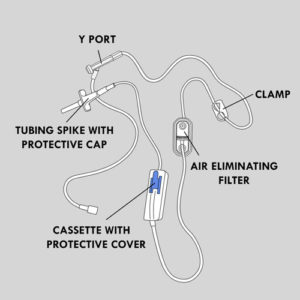Indications:
- The parenteral nutrition solution is prescribed by your child’s healthcare team and provided to you by a specialty pharmacy.
- Vitamins and possibly other additives are added to the bag before starting treatment.
- The steps in the method below may serve as a guide; speak to your healthcare team about the specific equipment that your child uses.
Considerations:
- Typically, a one week supply is delivered to your home.
- Each bag of solution is divided into 2 parts (chambers) separated by a partition device. The upper chamber contains lipids (fat), while the lower chamber contains amino acids and other nutrients essential for your child’s development (eg, sugars, electrolytes and trace elements). Each bag contains the amount of parenteral nutrition that your child requires for one day.
- Special tubing, with a sharp pointed end called a spike (covered in a protective cap) is used to connect to the insertion port of the parenteral nutrition bag. This special tubing is threaded through a rectangular device, called the cassette. The cassette also has a protective cover, which often is blue in colour. The tubing also has an air eliminating filter, a Y-port and a clamp.

- Vitamins and other additives are available in small containers called vials or glass ampoules.
- Vials are small glass bottles with a plastic protective cap covering a rubber lid (septum). A needle, attached to a syringe, is inserted through the rubber lid to draw up the contents of the the vial into the syringe.
- An ampoule is a small glass tube with a narrow neck that is snapped open; a special filter needle, attached to a syringe, is used to draw up the contents of the ampoule into the syringe. When the ampoule is broken open, small particles of glass may fall into the additive solution. The use of that special filter needle ensures that no glass particles enter the syringe.
- Preparing the bag and adding additives at home requires special attention to ensure safe preparation and to maintain the sterility of the parenteral solution.
- Regularly changing bag tubing also helps reduce the risk of infections.
- Storage of solution bags and additives:
- Keep the bags of nutrient solution in a refrigerator dedicated for this purpose. Keep the bags away from the “freezer” section to prevent them from accidental freezing.
- Check with the pharmacy whether vitamins and other additives require refrigeration or not.
- Ideally, the nutrient solution (with any additives) is at room temperature when it is infused into your child. Depending upon the volume of the bag, it generally takes at least one hour for the refrigerated solution to come to room temperature. Larger bags will require more time. Check with your child’s healthcare team for specific instructions for your child.
- Do not immerse the solution in hot water and do not put them in the microwave oven to warm them up.
- Place the parenteral nutrition bag on a clean surface, away from direct sources of heat and light; the bag can be kept in opaque protective wrapping (if present) or in a backpack that is used to facilitate administration.
- A bag of parenteral nutrition solution can be kept at room temperature for up to 48 hours. If vitamins have been added, shelf life at room temperature should not exceed 24 hours.
- Good handwashing is essential before and after providing care.
- Optimize your child’s comfort during care with appropriate positioning and the use of distraction.
Frequency:
- The preparation of the bag and the addition of additives can be done as soon the bag is removed from refrigeration and before it is time to administer the solution to your child.
- The tubing can be connected to the parenteral nutrition bag at the same time.
- New tubing should be used with each new bag of parenteral nutrition.
Required materials:
Refer to your healthcare team if the material used or the sequence of steps taught is different from what is described in the care method.








